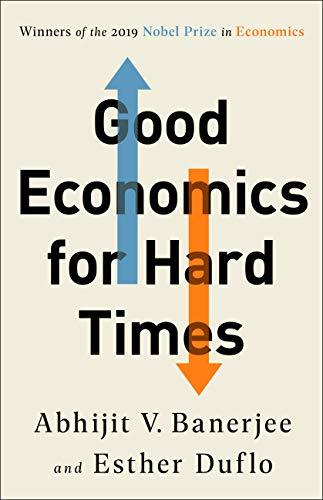Common Sense Economics that is Changing the World (and may also change your mind!)
As I read Good Economics for Hard Times, I couldn’t get out of my head James Collins’ simplistic dictum for businesses:
This is pretty much what husband and wife MIT economists, Esther Duflo and Abhijit Banerjee have been doing for several years now in their pioneering work in poverty economics. Somewhere in the world, sometimes in out-of-the-way places, people have tried stuff. Iceland, for example, helped to relocate fishermen who lost homes to a volcano. Mexico gave mothers money to take their kids to the doctor. Thousands of such programs, experiments, and even accidents, when taken together, have yielded a trove of information about how people behave economically.
Two decades ago, Duflo and Banerjee, together with a worldwide group of poverty researchers, began gathering the collective wisdom of such experiences. The resulting insights when turned into programs have made measurable differences in human well-being around the world.
The world has tried a lot of stuff and Banerjee and Duflo are helping it keep what works.
The authors’ first book, Poor Economics: A Radical Rethinking of the Way to Fight Global Poverty, brought the marriage of theoretical economics and evidence-gathering to a non-specialist readership. In 2003, Banerjee and Duflo collaborated with development economists worldwide and set up a network of poverty researchers called the Abdul Latif Jameel Poverty Action Lab, or J-PAL. This group has linked arms with governments and poverty-fighting non-profits to set up programs that really do make life easier for the world’s poor. Just before Good Economics was published, Duflo and Banerjee were awarded, along with fellow poverty economist, Michael Kremer, the 2019 Nobel Prize in Economics.
Americans right now are bogged down in a pandemic and dysfunctional national government. We lack the mental bandwidth to utilize fully what Banerjee and Duflo are putting on the table. But with time the entire world will be tackling several mega problems at once. I’m thinking of climate and race. Poverty is a thread that intertwines all issues. And the insights of these wonderful books and the methodology they set forth will be immensely useful.
What’s In Good Economics for Hard Times?
While poverty remains central in the authors’ second book, they have widened their focus and evidence-based methodology to include an array of timely issues. Many of these issues are bogged down in partisan differences and solutions that rely on “common sense” or intuitive approaches. America’s policy-makers are in the thrall of trite, unoriginal ideas that still drive policy or prevent change.
Senate Majority Leader, Mitch McConnell is a prime example. He appears to believe that approving any spending for social programs is bad for the country. That’s an example of the kind of formulaic approach that Banerjee and Duflo argue against. Such assumptions abound in Washington and America’s hyper-partisan populace. We make or reject policy by formula: Lowering taxes prompt growth. Social programs foster dependency. Regulation stifles small businesses.
Good Economics for Hard Times pioneers a different path. It bristles with little studies and quirky parallel situations from places Americans and apparently, economists usually don’t bother to check out. Refreshingly, there is not a single algorithm to be found in the book.
One might think that Good Economics is hotly controversial. It’s not. Banerjee and Duflo write in serene tones. They put forward devastating evidence without announcing that they’ve demolished some bromide that has underwritten policy for decades.
For the most part, conservative pieties suffer from the book’s withering rain of facts. But I don’t believe that conservatives would throw this book against the wall. The authors’ present their arguments staying close to the rich soil of data without being in too big a hurry to draw sweeping inferences. This tactic keeps Good Economics readable instead of infuriating.
There was one exception. The authors’ depiction of people in finance (banking, insurance, investments, and fund management) is savage and funny. The authors begin by establishing that there is no connection between job performance and compensation. They write,
The authors are making the point that the outsized salaries in finance ripple through the whole economy where executives in other (productive?) industries would merit similar compensation.
Each of Good Economic’s chapters is dedicated to a current issue like immigration or international trade. This topical arrangement makes the book easy to navigate and inviting as a reference book that can be easily consulted when issues are debated.
Three Core Lessons
In addition to the authors’ insistence on grounding policy in lived experience, as we’ve discussed, three other principles thread through the chapters. These, for me, are the real takeaways from my reading of this book. These are the new lenses through which I can view issues that may be otherwise be immersed in partisan emotionalism.

Stickiness. People don’t always do what economists predict they will do even if though they might be better off. For example, the Stolper–Samuelson Theorem, famously predicts that international trade will always be beneficial to all parties, even when a large powerful country trades with an undeveloped country. Such confidence in free trade underlies mega-trade deals such as NAFTA. But if you look at the American Rust Belt, with shuttered factories and unemployed workers, it’s pretty obvious that importing Asian goods has not been good at least for these Americans. What has happened? The displaced workers have not relocated nor received transition support to take advantage of trade’s economic benefits. There may be benefits from trade. But these are elsewhere in the form of lower prices for goods or new jobs. The displaced factory worker in Ohio sees none of this. This is the sticky economy. People can’t and don’t call in moving vans and learn new trades upon being laid off. The Stolper–Samuelson Theorem may be true, but not seem to be true for one group of people. The lesson to be learned here is that social programs that might provide retraining, unemployment compensation, and even assistance in relocation are necessary when trade deals are struck.

The Elusiveness of Growth: This is a powerful principle that has numerous ramifications. The authors argue at length that nobody knows the policy or policies that reliably prompt an expansion in a nation’s economy. Policymakers defend such tactics as tax cuts as growth stimulators. But lowering taxes in the United States has not resulted in sustained growth. Social welfare programs are seen as growth inhibitors and the United States suffers from a flimsy social safety net because lawmakers are chasing the mirage of growth. Banerjee and Duflo, recommend abandoning the quest for higher growth and focusing on social programs that have much more promise of directly improving people’s lives.

Underachieving Government: Ever since Ronald Reagan said that “…Government is the problem,” the United States has been plagued by a mistrust of solutions that are organized and financed in Washington or state capitals. The low tax, low regulation, high individualism climate in American economic life comes with an anti-government corollary, which sees public solutions to problems as invariably corrupt, expensive, and mediocre. Banerjee and Duflo cite instances worldwide where government programs, even ones that make direct cash transfers to the poor, are remarkably effective. The authors conclude that the United States must set aside its suspicion of government and labor to enact a slate of social welfare programs that bring the government into full partnership with private enterprise in advancing American well-being.

Good Economics for Hard Times: Chapter Summaries
Introduction and Chapter 1 Summary: “MEGA: Make Economics Great Again”
The Introduction and first chapter, titled: “Make Economics Great Again” make a plea for economics that is evidence-based as opposed to intuition-based. Duflo and Banerjee insist on taking a look at places where economic realities are being practiced. They then urge measuring how things are turning out. The authors advocate experimentation in situations where measurable data is not available. They might like the motto: “Try a lot of things and keep what works.” The authors argue against partisan theories that may drive policy but which fail to deliver consistent benefits. Such pieties would include the assumption that immigration takes jobs, that all trade is good, or that revenues always rise when taxes are reduced. The authors lament that academic economists lack influence and pseudo-economists tend to press views that align with their business interests. The world is changing fast and too many policy decisions are based on data-light, partisan assumptions, which are delivering mediocre results and leaving people behind.
Chapter 2 Summary: “From the Mouth of the Shark”
This chapter on immigration dispels two commonplace myths about migrating people. First, migrants do not pull up stakes and move out of economic motives. They move because some impossible situation forces them to look for tolerable conditions elsewhere. Second, migrants settling in a new place tend to enhance the local economy making life better both for themselves and for the natives, their new neighbors. The mutual benefit aspect of immigration is counter-intuitive for people who are schooled in the classic supply and demand curve principles, which would predict that an influx of abundant cheap labor would lower wages and drive natives out of jobs. This supply and demand thinking, however, is not fully applicable to immigration. These six factors, seen repeatedly in studies worldwide, are also in play when people move:
- Newcomers spend their earnings and enhance the local economy.
- Cheap and abundant labor encourages local businesses and farms to maintain labor-intensive production methods, thus maintaining many jobs.
- Employers are reluctant to get rid of satisfactory workers and familiar employees.
- When immigrants do work it is often at jobs and in places rejected by locals.
- High skill, high motivation immigrants set up businesses and hire locals.
- Cheap and abundant immigrant labor frees locals (often women) to transition to higher skill, higher pay jobs.
The authors conclude this chapter on immigration’s benefits by suggesting that governments create programs that encourage migration and support people who take up residence in another country or region. These four program types were listed as ways to enhance the chances that migrants will be successful in establishing a new life in a new place:
- Have a migration-positive messaging ethos, which communicates the costs and rewards of migration.
- Make it easy for migrants to exchange money to and from home.
- Offer migrants some form of insurance against failure.
- Offer housing assistance, job matching, childcare.
This chapter’s subtext is that anti-immigration political rhetoric is at bottom an appeal to racism and the public’s irrational fear of being engulfed by a foreign culture.
Chapter 3 Summary: “The Pains from Trade”
This chapter uses real-world experiences—as opposed to theoretical deductions—to steer a path between the economists’ orthodoxy that trade is good and the public’s perception that barriers would protect jobs. The discussion finally concludes what the iconic Samuelson-Stolper Theorum asserts, namely that winners in free trade need to be taxed with the proceeds going to the losers. Citing India’s recent experience of opening its markets to free trade, the authors concluded that both growth and inequality have been the result.
The authors move on to a complicated part of the discussion exploring whether growth can drive trade rather than the other way around. Additionally, Mexico, Columbia, Brazil, India, Argentina, and China have experienced growth in inequality with increased trade openness. Again causation and correlation may be mixed up with these generally expanding economies.
Referring to the previous chapter’s observation that people’s ability to relocate may not be as achievable as the SS Theory would wish, the chapter concludes with a closer look at US rustbelt areas that have been hurt by NAFTA and liberalized trade agreements in the 1980s and 1990s. The authors observe that out-of-work mid-western workers never received the kind of support necessary to acquire new skills and possibly relocate. Lacking what should have been a GI Bill-sized government intervention, too many American workers turned to disability and worse, to drugs and suicide.
Conclusions: the trade bills in the last few decades have not fired the American economy so very much. Trade, nevertheless, ought to be vigorous so that the country does not retreat into isolation and decline. When trade does leave victims, these individuals need a big infusion of support to recover.
Chapter 4 Summary: “Likes, Wants, and Needs”
The authors begin by acknowledging that America is having an upsurge in prejudice against people of different backgrounds. People who have kept quiet about their racism now feel empowered to speak explicitly about it. The economic piety that the authors are calling into question in this chapter is the idea that the free market will bring universal tolerance because everyone is a potential customer. The free market that America prides itself as having has not rectified its racial caste system, which now has disparities that exceed those of India.
This chapter addresses the core question of the origin of preferences for and against newcomers and different peoples. The authors want to say that animus against an out-group is not directed against its race so much as things associated with the race. Cops stalk young Black men, assuming them to be criminals because Blacks have a reputation for possessing a proclivity towards criminal behavior. The authors’ point is sharpened with their observation that the tendency act based on a stereotyped association is especially true in the case of one’s group and one’s self. The narrative we hold about ourselves tends to be self-fulfilling.
By way of illustration, the authors cite a study of cheating at a coin flipping game. When the study subjects were bankers who had been recently reminded that they were bankers, they cheated more. Bankers see themselves as ready to do whatever it takes to win or gain financially. When people lapse beneath their self-image, they feel badly enough to invent self-justifying explanations. Immigrants’ children end up in cages, not because of the cruelty of the border police, but because the immigrants should know better than to bring children into a dangerous situation.
One’s self-image drives us to congregate in like-minded groups, such as partisan social media enclaves or cable news watchers. This congregating reinforces extreme views because it is easy for algorithms to identify receptive recipients for propaganda. The chapter concludes by advocating a return to the principles on which the old affirmative action programs were based, namely intermixing peoples of different backgrounds as a way of moderating their outlook.
Chapter 5 Summary: “The End of Growth?”
This long chapter demonstrates that no one knows the magic charm that will bring economic growth back to the US, whose economy, since the 1970s, has slowed to rates between 2 and 3 percent growth per year. Even the advent of computers and the internet have not appreciably altered the low growth normal.
The bulk of the chapter explores a list of factors, assumed to be growth-stimulating, that have proven to be ineffective in nudging the US and other developed countries towards sustained increases in goods and services year on year. Developing countries can grow rapidly. This is because an infusion of capital investment can create many new jobs. Jobs create spending. Eventually, job creation will come into balance with capital, which is the equilibrium that the US and other large economies enjoy. It is the balance that tends to slow growth.
A variety of growth-stimulating measures have been tried and have failed to deliver. Regional development may help one area but at the price of depressing another region. Tax cuts, the darling program of America’s conservative Republicans have not consistently cranked up the economy.
One Theorist, Romer, proposed the creation of better, more efficient, cities. The plan failed to attract any interested nations. Romer also thought that all scientific and business ideas should freely circulate, unhampered by patients and proprietary secretiveness. This also foundered because it threatened business profitability. Given the elusiveness of a sure-fire growth formula, the authors suggest abandoning the quest. Now, they caution against growth killers:
- Hyperinflation
- Over-valued fixed exchange rates
- Communism
- Over-dominating governmental control
The authors do explore one final growth killer that haunts all economies, namely misallocation. The book cites developing world education which prepares students for non-existing jobs as classic misallocation. They conclude that if misallocation could be limited life really could improve despite lack of GDP numbers boost.
Chapter 6 Summary: “In Hot Water”
The sixth chapter takes on climate change, arguing in favor of an approach like the Green New Deal as central to reducing emissions worldwide. The authors’ opinion about climate change aligns with that of the IPCC. In other words, they see global heating as an existential threat. The chapter is clear-eyed about global warming’s chief culprits—rich countries and rich people in poor countries. Paradoxically, warming’s chief victims are the poor and poor countries. The dilemma of air conditioning in India serves as a central illustration. India’s citizens need more air conditioning but are discouraged from adopting it because it aggravates the climate problem. A similar case could be made concerning the increased consumption of meat.
As to policy: the authors promote a technology-based approach that would require a little reduction in life quality. This would be achieved by a Green New Deal approach, which places a carbon tax on consumption, mostly by the rich. The tax’s proceeds would then be redistributed to the less-well-off. This approach has several virtues. It burdens those ablest to pay, notably the big consumers. It preserves a reward for economizing on emissions. It buys time for the poor to transition to new, low-emissions technology. The main argument against such a program would be that it would be a growth killer. But the authors have already shown that growth is a mirage and pursuing it is generally futile.
The chapter concludes with the observation that quality of life enhancements are not always the byproduct of growth and pursuing them directly is much more promising than seeing growth as everything.
Chapter 7 Summary: “Player Piano”
The seventh chapter, “Player Piano” pulls together the authors’ insights about how jobs interact with social status in America. The chapter begins by stating that jobs are disappearing and that a smaller and smaller portion, from 50% – 10% of the GDP flows toward wage dependent households. Automation, including robotics, eliminates, and creates jobs. Because these jobs are often in a region different from the place where jobs were lost, the sticky economy prevents displaced wage earners from moving or retraining to fill those jobs. Labor’s share of wealth began with the Reagan revolution and has decreased, especially for non-college-educated workers. This problem drives America’s never-ending quest for growth. All the while, wealthy Americans, those receiving $500,000 annually or more, have seen rapid increases. The US and UK, as opposed to Western Europe, have had the most wealth and income inequality.
The authors list notable drivers of inequality.
First, they discuss “superstar businesses.” Walmart moves in and mom and pop go out. These in turn channel big compensation toward superstar executives.
Second, the financial sector, with its outsized compensation has grown compensation in finance is less tied to social benefit, which is to say finance creates millionaires who haven’t done anything useful These salaries set the bar for all executive pay.
Third, top tax rates have come down. While defended as an incentive for hard work, there is no correlation between personal productivity and compensation. Tax evasion does rise with higher taxes, but forthright governmental enforcement would probably limit this. There is no reason not to have a 70% top tax bracket to fund a more humane society. Because of the rise in inequality, Americans tend to blame themselves or scapegoats for their lack of mobility. This in turn gives rise to anti-immigration and racist sentiments and the self-destruction of the non-college-educated White working class.
Chapter 8 Summary: “Legit.gov”
The United States has adopted a low taxation, high freedom approach to social well-being, which allows money to stay in the hands of earners. This also supposedly avoids inefficiencies of the government as a middleman. Unfortunately, this approach contributes to inequality. Economists in at least 4 ways, contribute to the impression, articulated by President Reagan, that “government is the problem.”
- They suggest that people won’t work if burdened by higher taxes. Studies have shown that higher taxes are not correlated with less work.
- The idea that the government cannot be as effective as a private enterprise is generally accepted.
- Also generally assumed is that waste and abuse are rife when the government is in charge.
- People associate corruption more strongly with the government than with private enterprise.
All four of these ideas are not borne out in real-life studies. Nevertheless, assumptions result in four consequences that the US must now live with:
- Any new governmental responsibility tends to be out-of-hand rejected by decision-makers.
- The most talented employees shy away from government work.
- The association of government with corruption discourages decision-makers from assigning important work to the government.
- The government is simply dismissed as an important force.
As a result, the American government is chronically broken and it is
Chapter 9 Summary: “Cash and Care”
The final chapter, “Cash and Care” ponders and at length rejects the adoption in America of Universal Basic Income. The chapter’s first half makes a compelling case for UBI, citing several developing world examples where it has worked. Banerjee and Duflo note how much energy it takes for means tested or quid pro quo poverty programs to be administered. They further acknowledge the fact that a $1000 per month program for every adult American would add 1.3 trillion to the existing 2.6 trillion spent on welfare programs. This would require raising taxes somewhat. At length, the authors reject UBI for America because many American retirees and the unemployed do in fact spend their out of work time poorly, watching television and sleeping.
The chapter concludes by listing several ways that existing American social programs, from job training to childcare could address job disruption and unemployment. The authors finish the book insisting that the primacy of human dignity ought to be the center goal of all social welfare programs.

One Reply to “Common Sense Economics that is Changing the World (and may also change your mind!)”
Thank you for reading.